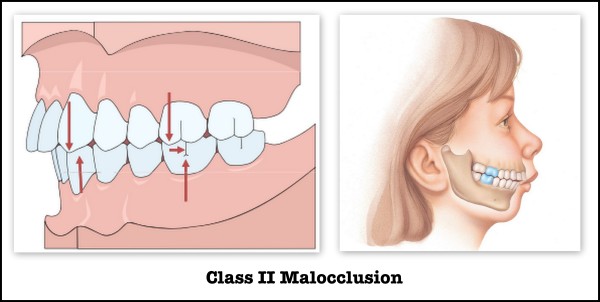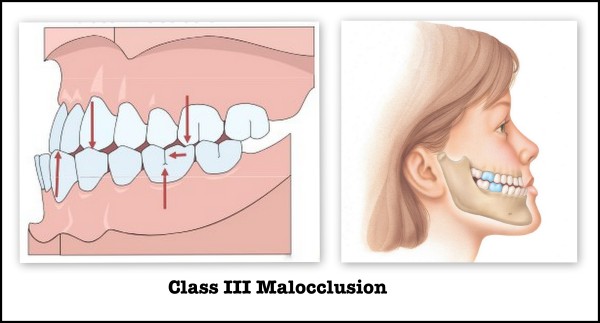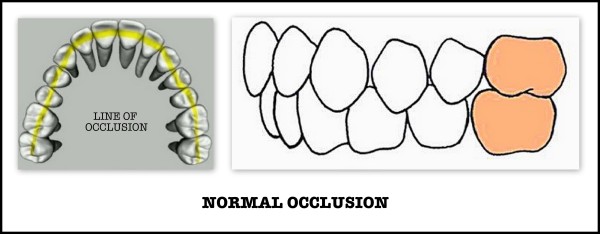ANGLE’S CLASSIFICATION OF MALOCCLUSION
A malocclusion is a misalignment or incorrect relation between the teeth of the two dental arches when they approach each other as the jaws close. Edward Angle, who is considered the father of modern orthodontics, was the first to classify malocclusion. He based his classifications on the relative position of the permanent MAXILLARY FIRST MOLAR. Angle believed that the anteroposterior dental base relationship could be assessed reliably from first permanent molar relationship, as its position remained constant following eruption. In case where the first molars were missing, CANINE relationship is used.
 ANGLE’S CLASSIFICATION OF MALOCCLUSION
ANGLE’S CLASSIFICATION OF MALOCCLUSION
NORMAL OCCLUSION
Molar Relationship: According to Angle, the mesiobuccal cusp of the maxillary first molar aligns with the buccal groove of the mandibular first molar.
Canine Relationship: The maxillary canine occludes with the distal half of the mandibular canine and the mesial half of the mandibular first premolar.
Line of Occlusion: The teeth all fit on a line of occlusion which, in the upper arch, is a smooth curve through the central fossae of the posterior teeth and cingulum of the canines and incisors, and in the lower arch, is a smooth curve through the buccal cusps of the posterior teeth and incisal edges of the anterior teeth. There is alignment of the teeth, normal overbite and overjet and coincident maxillary and mandibular midlines.
…..
ANGLE Class I: NEUTROOCCLUSION
Molar Relationship: The mesiobuccal cusp of the maxillary first permanent molar occludes with the mesiobuccal groove of the mandibular first permanent molar.
Canine Relationship: - The mesial incline of the maxillary canine occludes with the distal incline of the mandibular canine. The distal incline of the maxillary canine occludes with the mesial incline of the mandibular first premolar .
Line of Occlusion: ALTERED in the maxillary and mandibular arches
.
– Individual tooth irregularities (crowding/spacing/other localized tooth problems).
– Inter-arch problems (open bite/deep bite/cross bite)
.
Mesognathic: normal, straight face profile with flat facial appearance.
….
ANGLE Class II: DISTOOCCLUSION (overjet)
Molar relationship: The molar relationship shows the mesiobuccal groove of the mandibular first molar is DISTALLY (posteriorly) positioned when in occlusion with the mesiobuccal cusp of the maxillary first molar. Usually the mesiobuccal cusp of maxillary first molar rests in between the first mandibular molar and second premolar.
Canine Relationship: The mesial incline of the maxillary canine occludes ANTERIORLY with the distal incline of the mandibular canine. The distal surface of the mandibular canine is POSTERIOR to the mesial surface of the maxillary canine by at least the width of a premolar.
Line of occlusion is not specified but irregular, depending on facial pattern, overcrowded teeth and space needs.
Retrognatic: convex face profile resulting from a mandible that is too small or maxilla that is too large.
 Class II Malocclusion has 2 subtypes to describe the position of anterior teeth:
Class II Malocclusion has 2 subtypes to describe the position of anterior teeth:
• Class II Division 1: The molar relationships are like that of Class II and the maxillary anterior teeth are protruded. Teeth are proclaimed and a large overjet is present.
• Class II Division 2: The molar relationships are Class II where the maxillary central incisors are retroclined. The maxillary lateral incisor teeth may be proclaimed or normally inclined. Retroclined and a deep overbite exists.
CLASS II Sub-division: Class II molar relationship exists on one side and the other side has a normal Class I molar relationship.
….
ANGLE Class III: MESIOOCCLUSION (negative overjet)
Molar relationship: The mesiobuccal cusp of the maxillary first permanent molar occludes DISTALLY (posteriorly) to the mesiobuccal groove of the mandibular first molar.
Canine Relationship: Distal surface of the mandibular canines are mesial to the mesial surface of the maxillary canines by at least the width of a premolar . Mandibular incisors are in complete crossbite.
Line of occlusion is not specified but irregular, depending on facial pattern, overcrowded teeth and space needs.
Prognathic: concave face profile with prominent mandible is associated with Class III malocclusion.
 Class III malocclusion has 2 subdivisions:
Class III malocclusion has 2 subdivisions:
1. TRUE class III malocclusion (SKELETAL) which is genetic in origin due to excessively large mandible or smaller than normal maxilla.
2. PSEUDO Class III malocclusion (FALSE or postural) which occurs when mandible shifts anteriorly during final stages of closure due to premature contact of incisors or the canines. Forward movement of the mandible during jaw closure can also result from premature loss of deciduous posterior teeth.
Class III Sub-division: Class III molar relationship exists on one side and the other side as a normal Class I molar relationship.



Nice work!
LikeLiked by 1 person
Oh my god ! Thank you so much for this post .. It’s really helpful.
My teacher just asked us these questions in class . And I didn’t know a word .
Thanks again.
LikeLiked by 1 person
Thank you for the kind words. Good luck with your studies. 🙂
LikeLike
Thank you so much. This was very helpful
LikeLike
I love how simply this is explained.
LikeLike
Thank you.
LikeLike
Thank you
LikeLike
Reblogged this on .
LikeLike
please could you tell your references?
LikeLike
Is convenient for using this website
LikeLike
Hi! Nice work indeed. BTW i am writing a course manual and i would like to use the 3 images where there is a face on the right. If you could provide me the reference for those images it would be very appreciated ! Thank 🙂
LikeLike
Thanks For this lessons…
LikeLike
Pingback: All You Need to Know about Braces for Your Children - Playbrush
Hello. Would you give me permission to use your diagrams on Class I, Class II, and Class III malocclusion? They are excellent. I need to use them in a presentation for families of cleft lip and palate patients.
LikeLiked by 2 people
Pingback: Why Kane Brown Has Service Dogs – Ask Pet Guru
Pingback: Buck Teeth: Everything you should know about them - Novoliv
Pingback: Unveiling the World of Canine Communication: How to Sign Dog Breeds in ASL – PatchPets